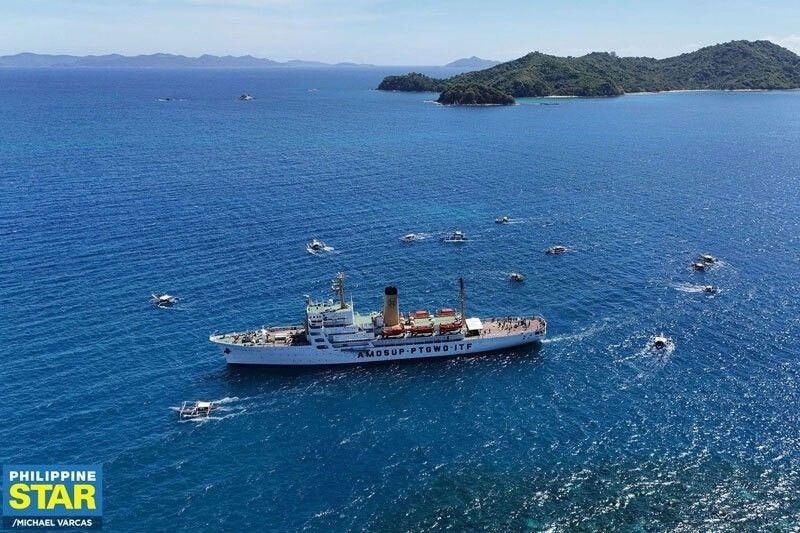Fish catch in West Philippine Sea grows despite tensions with China
MANILA, Philippines — Despite rising tensions with China, the Philippines expanded its fish catch in the West Philippine Sea (WPS) last year to a four-year high of over 200,000 metric tons on the back of higher state support to fishermen. Citing Philippine Statistics Authority (PSA) data, the Bureau of Fisheries and Aquatic Resources (BFAR) said […]


MANILA, Philippines — Despite rising tensions with China, the Philippines expanded its fish catch in the West Philippine Sea (WPS) last year to a four-year high of over 200,000 metric tons on the back of higher state support to fishermen.
Citing Philippine Statistics Authority (PSA) data, the Bureau of Fisheries and Aquatic Resources (BFAR) said the country’s fisheries output in the WPS in 2023 reached 201,894.49 metric tons, almost 15 percent more than the 175,784.73 MT recorded in 2022.
The BFAR explained that the fisheries output in the WPS was based on the fish catch recorded by both commercial and marine municipal subsectors in eight provinces: Ilocos Norte, Ilocos Sur, La Union and Pangasinan (Region 1); Bataan and Zambales (Region 3), and Occidental Mindoro and Palawan (Region 4A).
The data were culled by the BFAR from the latest figures released by the PSA on the country’s fisheries production.
BFAR, an attached agency of the Department of Agriculture, attributed the increase in WPS fish catch to its interventions last year to fisherfolk through its Livelihood Activities to Enhance Fisheries Yields and Economic Gains from the West Philippine Sea (LAYAG-WPS) program.
BFAR said it provided fuel subsidies and various fishing equipment like fiberglass boats, payao and post-harvest equipment to some of the estimated 385,000 Filipino fishermen catching in the WPS.
“These key interventions not only alleviated financial burdens on small-scale fishermen, but also enhanced their mobility and safety, and enabled them to explore broader waters and increase catch volumes,” BFAR told The STAR.
Historical government data showed that the country’s fisheries output in the WPS last year was the highest in four years or since the 212,830.87 metric tons recorded in 2019.
Fish catch from the WPS accounts for about seven percent on the average of the country’s annual fish supply for food consumption.
Sustained government support
The BFAR vowed to sustain its interventions to fishermen sailing to the WPS under its LAYAG-WPS program, which had an P80 million budget last year.
The BFAR earlier disclosed that it is spending P2.5 billion this year for the procurement of new floating assets as it boosts its presence in the WPS and assists fishermen better.
“Resources have also been allocated for the construction of an aqua feed mill, operation of a community fish landing center, and implementation of the salt program in the regions covered by the WPS,” the BFAR said.
International marine conservation organization Oceana urged BFAR to enhance the implementation of the mandatory installment of vessel monitoring measures (VMM) in all commercial fishing vessels to have better monitoring of the country’s fish stocks, including those in the WPS.
Citing BFAR data, Oceana said only 81 percent of the commercial fishing vessels are installed with VMM. The mandatory installment of VMM began in 2020.
“With all Philippine-registered commercial fishing vessels identified and their location of fishing activities traced, the Philippine government will be able to track them while plying the West Philippine Sea, record their catch and enable the government to monitor the state of our fish stocks in this important fishing ground,” Oceana vice president Gloria Estenzo Ramos told The STAR.
Intensify monitoring
Ramos emphasized that the VMM would address issues of overfishing and illegal, unreported and unregulated fishing across the country’s waters by tracking and determining the state registration of commercial fishing vessels.
Ramos pointed out that the VMM will help the government to determine illegal fishers in the WPS as the measure would determine “non-Filipino” fishers in the country’s EEZ.
“Without the VMM, the government is blind to the identities of Philippine-flagged fishing vessels,” she said while noting that foreign fishing vessels are difficult to identify once they switch off their automatic identification systems.
The BFAR added that it will also intensify its monitoring, control and surveillance (MCS) activities in the WPS by procuring two units of MCS vessels and a food boat.
Furthermore, the bureau said it will operationalize an integrated marine environment monitoring system and implement an information systems strategic plan.
BFAR earlier noted that its P1.817 billion confidential and intelligence fund would boost its MCS activities in WPS and ensure “sustainable” use of marine resources and “safeguard” the livelihoods of Filipino fishermen in the WPS.
BFAR documents showed that it recorded 305 vessels within the country’s exclusive economic zone in the WPS between 2022 and 2023.
Of the total figure, about 266 were identified as fishing vessels while the remaining vessels were for military operations.
BFAR said 144 of the monitored fishing vessels came from China and 71 from Vietnam, during the reference period. Meanwhile, there were 49 Philippine fishing vessels monitored and documented in the WPS that came from Regions 1, 3, 4B, 12 and the National Capital Region.














